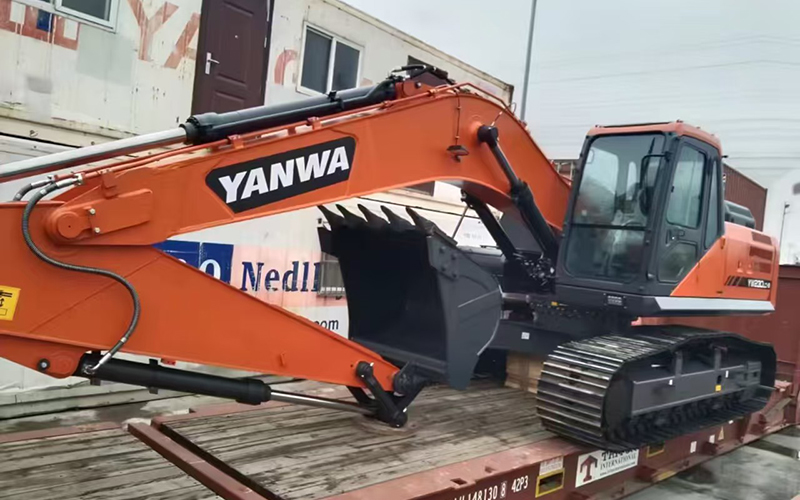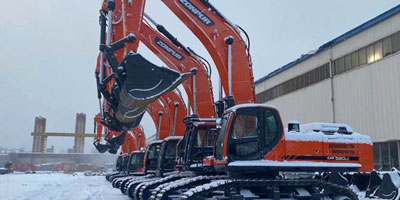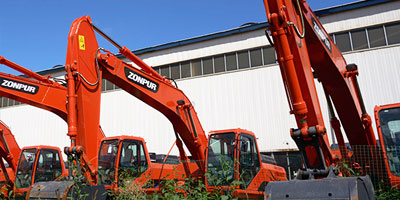The problem of black smoke and sudden power reduction in excavator engines is quite complex and may be caused by various factors:
Fuel system issues
Fuel injector malfunction:
Reason: The fuel injector is clogged, worn, or unevenly sprayed. When the fuel injector is blocked, the fuel injection is not smooth, resulting in poor fuel atomization. This prevents the fuel from fully burning in the cylinder, and incompletely burned fuel is emitted in the form of black smoke. Worn fuel injectors can change the shape and angle of fuel injection, which also affects the fuel atomization effect.
Inspection method: Use the nozzle tester to check the injection pressure, spray shape and injection uniformity of the nozzle. Under normal circumstances, the fuel sprayed from the fuel injector should be in the form of mist, and the difference in fuel injection quantity between each injector should be within a reasonable range.
Solution: For clogged fuel injectors, professional nozzle cleaning equipment can be used for cleaning. If the fuel injector is severely worn, a new fuel injector needs to be replaced.
Fuel filter blockage:
Reason: The function of a fuel filter is to filter out impurities in the fuel. If the filter is not replaced or blocked by impurities for a long time, it will limit the supply of fuel. This results in insufficient fuel entering the cylinder, causing an imbalance in the mixing ratio of fuel and air, resulting in incomplete combustion of fuel, producing black smoke, and reducing power.
Inspection method: Observe the pressure difference between the two ends of the fuel filter. If the pressure difference is too large, it indicates that the filter may be clogged. You can also remove the filter and check if the internal filter element is covered by impurities.
Solution: Regularly replace the fuel filter according to the cycle specified in the excavator's user manual. If blockage occurs during non replacement periods, a new filter should be replaced immediately.
Poor fuel quality:
Reason: Fuel that does not meet the requirements of the excavator was used, such as low fuel grade, high sulfur content, or moisture content. Low grade fuel has poor blast resistance and is prone to premature combustion in the cylinder, resulting in incomplete combustion. Fuel with high sulfur content will produce more harmful gases, including black smoke, after combustion. The moisture in fuel can affect the combustion process and reduce the power output of the engine.
Inspection method: Check the source and quality of the fuel, check whether the fuel is clear, and whether there is any odor or impurities. Sampling and testing of fuel can be conducted to check whether its grade, sulfur content, and other indicators meet the requirements.
Solution: Use high-quality fuel that meets the requirements of excavator engines and avoid using fuel from unknown sources. If poor fuel quality is found, the fuel in the fuel tank should be emptied, the fuel system should be cleaned, and then qualified fuel should be added.
Air intake system issues
Air filter blockage:
Reason: The air filter is used to filter the air entering the engine. If the filter is clogged with dust, debris, etc., it will reduce the amount of air entering the cylinder. According to the working principle of the engine, fuel and air need to be mixed in a certain proportion to burn fully. Insufficient air volume can lead to an imbalance in the mixing ratio of fuel and air, causing incomplete combustion of fuel, resulting in black smoke and reduced power.
Inspection method: Check if the filter element of the air filter is covered by dust, leaves, and other debris. It can be judged by observing the color and degree of blockage of the filter element. Generally speaking, the color of the filter element with severe blockage will become very dark.
Solution: Regularly clean or replace the filter element of the air filter. In dusty working environments, the cleaning or replacement cycle of the filter element should be shortened.
Air leakage in intake duct:
Reason: Air leakage can be caused by broken intake ducts, aging seals, or loose interfaces. This will reduce the effective amount of air entering the cylinder, causing uneven mixing of fuel and air, resulting in insufficient combustion, and ultimately leading to black smoke and decreased power.
Inspection method: Carefully inspect all parts of the intake duct, including the duct itself, seals, and interfaces, to see if there are any sounds or signs of air leakage. You can apply soapy water to areas where there may be air leakage. If bubbles are generated, it indicates the presence of air leakage.
Solution: For broken intake pipes, a new pipe needs to be replaced. If the seal is aging or the interface is loose, the seal should be replaced and the interface should be tightened to ensure the sealing of the intake pipe.
Engine mechanical issues
Wear or damage of piston rings:
Reason: The function of the piston ring is to seal the cylinder, prevent gas leakage, and transfer the heat generated by combustion to the cylinder wall. If the piston ring is worn or damaged, it will cause poor cylinder sealing, partial gas leakage, and a decrease in engine power. Meanwhile, gas leaks can disrupt the combustion process, causing incomplete combustion of fuel and producing black smoke.
Inspection method: Determine the working status of the piston ring by measuring the cylinder pressure. If the cylinder pressure is below the normal range, it may be a problem with the piston rings. In addition, the wear of the piston rings can also be directly observed after disassembling the engine.
Solution: If the wear of the piston ring is light, the problem can be solved by replacing the piston ring. If the piston rings are severely damaged or the cylinder walls are also worn, engine overhaul may be necessary, including cylinder boring, piston replacement, and other operations.
Poor valve sealing:
Reason: The function of the valve is to control the inflow and outflow of fuel and air. If the valve seal is not tight, it can cause fuel and air leaks, leading to abnormal combustion processes. Poor sealing of the intake valve can result in insufficient intake volume, while poor sealing of the exhaust valve can lead to residual exhaust gas. Both of these situations can cause an imbalance in the mixing ratio of fuel and air, resulting in incomplete combustion of fuel, black smoke, and reduced power.
Inspection method: The valve sealing can be checked by injecting compressed air into the cylinder and observing whether there is any air leakage around the valve. Professional valve sealing testing equipment can also be used for inspection.
Solution: For cases where the valve seal is not tight, it is necessary to grind the valve or replace the valve oil seal and other sealing components. If the valve itself is damaged, it may need to be replaced.
Turbocharging system issue (if excavator is equipped with turbocharging)
Turbocharger malfunction:
Reason: Malfunction of the turbocharger can affect the intake volume. For example, damage to the impeller, bearing wear, or poor sealing on the intake and exhaust sides of a turbocharger can lead to reduced boost efficiency or air leakage. This reduces the amount of air entering the cylinder, causing uneven mixing of fuel and air, resulting in incomplete combustion of fuel, black smoke, and decreased power.
Inspection method: Check the appearance of the turbocharger for any damage, such as cracks or deformations in the impeller. Listen for any abnormal sounds during the operation of the turbocharger, such as whistling or friction. The working status of the turbocharger can also be determined by detecting the intake pressure.
Solution: If the turbocharger malfunctions, it usually requires professional personnel to repair or replace it. Because the turbocharger is a precision component, the repair or replacement process requires strict technical specifications to be followed.



 +8613356922335
+8613356922335








